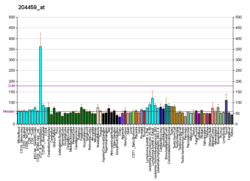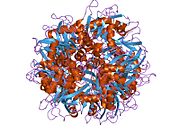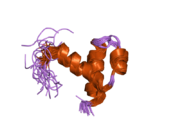Polyadenylation is the addition of a poly(A) tail to an RNA transcript, typically a messenger RNA (mRNA). The poly(A) tail consists of multiple adenosine monophosphates; in other words, it is a stretch of RNA that has only adenine bases. In eukaryotes, polyadenylation is part of the process that produces mature mRNA for translation. In many bacteria, the poly(A) tail promotes degradation of the mRNA. It, therefore, forms part of the larger process of gene expression.
Cleavage stimulatory factor or cleavage stimulation factor is a heterotrimeric protein, made up of the proteins CSTF1 (55kDa), CSTF2 (64kDa) and CSTF3 (77kDa), totalling about 200 kDa. It is involved in the cleavage of the 3' signaling region from a newly synthesized pre-messenger RNA (mRNA) molecule. CstF is recruited by cleavage and polyadenylation specificity factor (CPSF) and assembles into a protein complex on the 3' end to promote the synthesis of a functional polyadenine tail, which results in a mature mRNA molecule ready to be exported from the cell nucleus to the cytosol for translation.
Cleavage and polyadenylation specificity factor (CPSF) is involved in the cleavage of the 3' signaling region from a newly synthesized pre-messenger RNA (pre-mRNA) molecule in the process of gene transcription. It is the first protein to bind to the signaling region near the cleavage site of the pre-mRNA, to which the poly(A) tail will be added by polynucleotide adenylyltransferase. The upstream signaling region has the canonical nucleotide sequence AAUAAA, which is highly conserved across the vast majority of pre-mRNAs. A second downstream signaling region, located on the portion of the pre-mRNA that is cleaved before polyadenylation, consists of a GU-rich region required for efficient processing.
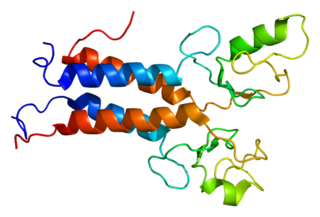
BRCA1-associated RING domain protein 1 is a protein that in humans is encoded by the BARD1 gene. The human BARD1 protein is 777 amino acids long and contains a RING finger domain, four ankyrin repeats, and two tandem BRCT domains.

60S ribosomal protein L5 is a protein that in humans is encoded by the RPL5 gene.

Splicing factor U2AF 35 kDa subunit is a protein that in humans is encoded by the U2AF1 gene.
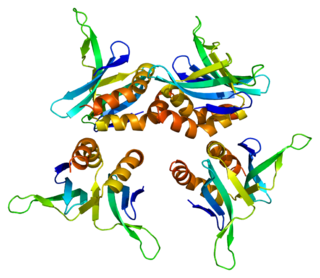
Activated RNA polymerase II transcriptional coactivator p15 also known as positive cofactor 4 (PC4) or SUB1 homolog is a protein that in humans is encoded by the SUB1 gene. The human SUB1 gene is named after an orthologous gene in yeast.

Cyclin-C is a protein that in humans is encoded by the CCNC gene.

Ubiquitin-conjugating enzyme E2 D1 is a protein that in humans is encoded by the UBE2D1 gene.
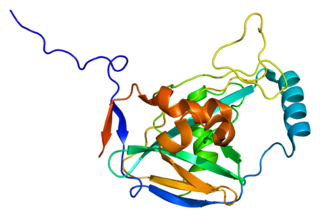
Cleavage and polyadenylation specificity factor subunit 5 (CPSF5) is an enzyme that in humans is encoded by the NUDT21 gene. It belongs to the Nudix family of hydrolases.

Cleavage and polyadenylation specificity factor subunit 2 is a protein that in humans is encoded by the CPSF2 gene.

Cleavage and polyadenylation specificity factor subunit 1 is a protein that in humans is encoded by the CPSF1 gene.

Poly(A) polymerase alpha is an enzyme that in humans is encoded by the PAPOLA gene.
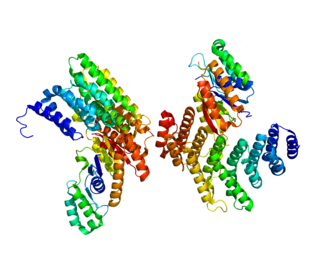
Symplekin is a protein that in humans is encoded by the SYMPK gene.

Cleavage stimulation factor 50 kDa subunit is a protein that in humans is encoded by the CSTF1 gene.

Cleavage stimulation factor 77 kDa subunit is a protein that in humans is encoded by the CSTF3 gene.
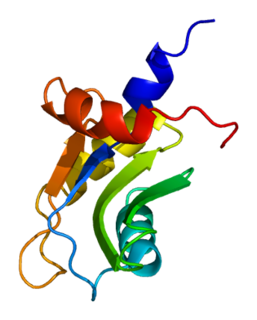
Cleavage stimulation factor 64 kDa subunit, tau variant is a protein that in humans is encoded by the CSTF2T gene.

Cleavage and polyadenylation specificity factor subunit 3 is a protein that in humans is encoded by the CPSF3 gene.

Cleavage and polyadenylation specificity factor subunit 4 is a protein that in humans is encoded by the CPSF4 gene.

General transcription factor IIF subunit 1 is a protein that in humans is encoded by the GTF2F1 gene.





